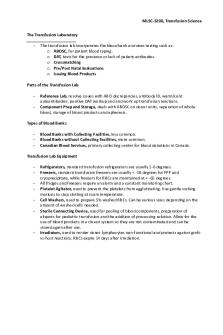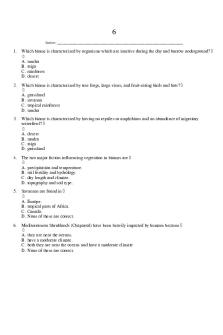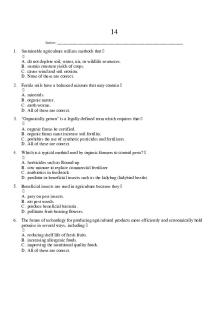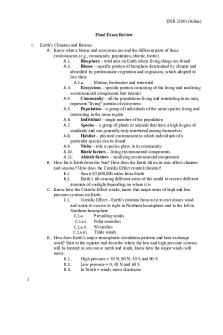6 - An intro to environmental science course PDF

| Title | 6 - An intro to environmental science course |
|---|---|
| Course | Environmental Science |
| Institution | American University of Sharjah |
| Pages | 29 |
| File Size | 271.4 KB |
| File Type | |
| Total Downloads | 102 |
| Total Views | 163 |
Summary
An intro to environmental science course...
Description
6 Student: ___________________________________________________________________________
1.
Which biome is characterized by organisms which are inactive during the day and burrow underground? A. tundra B. taiga C. rainforest D. desert
2.
Which biome is characterized by tree frogs, large vines, and fruit-eating birds and bats? A. grassland B. savanna C. tropical rainforest D. tundra
3.
Which biome is characterized by having no reptiles or amphibians and an abundance of migratory waterfowl? A. desert B. tundra C. taiga D. grassland
4.
The two major factors influencing vegetation in biomes are A. precipitation and temperature. B. soil fertility and hydrology. C. day length and climate. D. topography and soil type.
5.
Savannas are found in A. Europe. B. tropical parts of Africa. C. Canada. D. None of these are correct.
6.
Mediterranean Shrublands (Chaparral) have been heavily impacted by humans because A. they are near the oceans. B. have a moderate climate. C. both they are near the oceans and have a moderate climate D. None of these are correct.
7.
In a rainforest, most of the sunlight is captured by trees and therefore only A. small plants grow there. B. fast growing trees and shrubs grow there. C. vines can grow underneath them. D. shade-tolerant plants live beneath the canopy.
8.
Human impact on temperate forests include A. farming. B. logging. C. population centers. D. All of these are correct.
9.
Oceans cover approximately A. 40% of the Earth's surface. B. 50% of the Earth's surface. C. 60% of the Earth's surface. D. 70% of the Earth's surface.
10. Which group of organisms forms the base of the energy pyramid in a pelagic marine ecosystem? A. plankton B. zooplankton C. bacteria D. sea grass 11. In desert biomes, flowering usually coincides with A. moisture availability. B. Santa Anna winds. C. cool summers. D. migration of monarch butterflies. 12. Which of the following is NOT a threat to tropical rainforests? A. logging B. ranching C. agriculture D. All are threats. 13. In addition to northern latitudes, patches of tundra-like plant communities are also found A. in cold deserts. B. in marshes. C. in bogs. D. on mountain tops.
14. Which of the following is NOT a characteristic of temperate deciduous forests? A. They have fewer species than a tropical rainforest. B. They contain shade-tolerant spring wildflowers. C. They produce useful plant products such as cashew nuts, vanilla, and rubber. D. All of the choices are characteristics. 15. Which of the following is NOT true of climax communities? A. They have fewer types of interactions among organisms. B. They have more kinds of organisms. C. They are in energy balance. D. They are able to maintain their mix of species. 16. Which is an example of secondary succession? A. bare rock B. a burned field C. standing water D. pure sand 17. Primary succession is A. a progression that begins with a total lack of organisms. B. of very short duration. C. a progression that begins with destruction of an existing ecosystem. D. All of these are correct. 18. Development and impact on desert areas is mainly due to A. air conditioning. B. roads and highways. C. modern irrigation. D. None of these are correct. 19. What is the dominant organism colonizing bare rock during primary succession? A. bacteria B. algae C. lichens D. submergent plants 20. Each stage in the process of succession is called a A. seral stage. B. primary stage. C. reef-forming stage. D. None of these are correct.
21. Ecologists have learned that succession is influenced by many factors other than climate alone including A. rainfall and temperature patterns. B. invasive species, disease, human land use history, and seed dispersal. C. biogeochemical cycles, available oxygen, and superfund sites. D. slope, wind patterns, and toxicity levels. 22. A floating bog is an example of A. secondary succession. B. aquatic primary succession. C. terrestrial primary succession. D. None of these are correct. 23. Savannas differ from grasslands by having A. less annual precipitation. B. lower average annual temperature. C. no grazers. D. flat-topped trees scattered throughout. 24. Which of the following is NOT a region in a lake ecosystem? A. limnetic zone B. pelagic zone C. euphotic zone D. littoral zone 25. Shallow warm nutrient-rich lakes are described as A. oligotrophic. B. benthic. C. eutrophic. D. limnetic. 26. What is the term used to describe a shallow, partially enclosed area where freshwater enters the ocean? A. coral reef B. abyssal ecosystem C. mangrove swamp D. estuary 27. Seaweed and other attached marine organisms prefer to grow in which of the following regions? A. benthic B. pelagic C. abyssal D. neritic
28. The unusual forest biome occurring in California, Oregon, Washington, and British Columbia is called a A. tropical rainforest. B. boreal forest. C. temperate rainforest. D. temperate deciduous forest 29. Conservation easements can A. decrease the economic value of a tract of land. B. restrict access in order to protect endangered species. C. prohibit the subdivision or development of a tract of land. D. All of the above are correct. 30. You would find a temperate rainforest along the coasts of all of the following states except A. southern Alaska. B. northern California. C. northern British Columbia. D. northern New York. 31. Seasonal flooding of the Amazon can create wetland forests known as A. the chaparral. B. the tropical forest. C. the varzea. D. the terra firma. 32. Plants in this biome have features to survive long drought even though rainfall totals can be as high as 250 cm in a given month. A. savanna B. tundra C. desert D. tropical dry forest Which of the following best matches the description?
33. Biome that lacks trees and has permanently frozen soil. A. phytoplankton B. littoral zone C. desert D. pioneer community E. grassland F. boreal forest G. pelagic H. tundra I. benthic J. deciduous forest K. biochemical oxygen demand L. periphyton M. marsh N. savanna O. euphotic 34. Area of grasses and reeds that is either flooded permanently or for most of the year. A. phytoplankton B. littoral zone C. desert D. pioneer community E. grassland F. boreal forest G. pelagic H. tundra I. benthic J. deciduous forest K. biochemical oxygen demand L. periphyton M. marsh N. savanna O. euphotic 35. Photosynthetic free-floating marine organisms. A. phytoplankton B. littoral zone C. desert D. pioneer community E. grassland F. boreal forest G. pelagic H. tundra I. benthic J. deciduous forest K. biochemical oxygen demand L. periphyton M. marsh N. savanna O. euphotic
36. Biome which is dominated by grass, and in which trees are rare. A. phytoplankton B. littoral zone C. desert D. pioneer community E. grassland F. boreal forest G. pelagic H. tundra I. benthic J. deciduous forest K. biochemical oxygen demand L. periphyton M. marsh N. savanna O. euphotic 37. Biome which receives less than 25 cm of precipitation per year. A. phytoplankton B. littoral zone C. desert D. pioneer community E. grassland F. boreal forest G. pelagic H. tundra I. benthic J. deciduous forest K. biochemical oxygen demand L. periphyton M. marsh N. savanna O. euphotic 38. Upper layer of the ocean where the sun's rays penetrate. A. phytoplankton B. littoral zone C. desert D. pioneer community E. grassland F. boreal forest G. pelagic H. tundra I. benthic J. deciduous forest K. biochemical oxygen demand L. periphyton M. marsh N. savanna O. euphotic
39. Region with rooted vegetation in a freshwater ecosystem. A. phytoplankton B. littoral zone C. desert D. pioneer community E. grassland F. boreal forest G. pelagic H. tundra I. benthic J. deciduous forest K. biochemical oxygen demand L. periphyton M. marsh N. savanna O. euphotic 40. Early stages of succession that begin the soil-building process. A. phytoplankton B. littoral zone C. desert D. pioneer community E. grassland F. boreal forest G. pelagic H. tundra I. benthic J. deciduous forest K. biochemical oxygen demand L. periphyton M. marsh N. savanna O. euphotic 41. Biome composed of a broad band of coniferous and deciduous trees. A. phytoplankton B. littoral zone C. desert D. pioneer community E. grassland F. boreal forest G. pelagic H. tundra I. benthic J. deciduous forest K. biochemical oxygen demand L. periphyton M. marsh N. savanna O. euphotic
42. Biome that has a change of seasons and evenly distributed annual precipitation. A. phytoplankton B. littoral zone C. desert D. pioneer community E. grassland F. boreal forest G. pelagic H. tundra I. benthic J. deciduous forest K. biochemical oxygen demand L. periphyton M. marsh N. savanna O. euphotic 43. Organisms that swim in the open ocean water. A. phytoplankton B. littoral zone C. desert D. pioneer community E. grassland F. boreal forest G. pelagic H. tundra I. benthic J. deciduous forest K. biochemical oxygen demand L. periphyton M. marsh N. savanna O. euphotic 44. Organisms that live on the bottom of marine or freshwater ecosystems. A. phytoplankton B. littoral zone C. desert D. pioneer community E. grassland F. boreal forest G. pelagic H. tundra I. benthic J. deciduous forest K. biochemical oxygen demand L. periphyton M. marsh N. savanna O. euphotic
45. Biome dominated by grasses and fire- and drought-resistant trees. A. phytoplankton B. littoral zone C. desert D. pioneer community E. grassland F. boreal forest G. pelagic H. tundra I. benthic J. deciduous forest K. biochemical oxygen demand L. periphyton M. marsh N. savanna O. euphotic 46. Attached organisms in freshwater streams and rivers. A. phytoplankton B. littoral zone C. desert D. pioneer community E. grassland F. boreal forest G. pelagic H. tundra I. benthic J. deciduous forest K. biochemical oxygen demand L. periphyton M. marsh N. savanna O. euphotic 47. Amount of oxygen required to destroy organic molecules in aquatic ecosystems. A. phytoplankton B. littoral zone C. desert D. pioneer community E. grassland F. boreal forest G. pelagic H. tundra I. benthic J. deciduous forest K. biochemical oxygen demand L. periphyton M. marsh N. savanna O. euphotic
48. Ecologists have discovered that the process of succession is very predictable. True False 49. Recently, biologists discovered a new community of organisms that live in the canopy of tropical rainforests. True False 50. Most temperate deciduous forests have survived without impact from human activity due to their location. True False 51. Taiga, Northern Coniferous Forest, and Boreal Forest are names for the same type of biome. True False 52. Hurricanes, flooding, and fire are examples of disturbances which result in secondary succession. True False 53. In general, the soil of climax seral stages is less fertile than the soil of pioneer communities. True False 54. Muddy shores are often poor in oxygen. True False 55. Coral reefs are cold-water marine ecosystems dominated by tubeworms. True False 56. Streams differ from lakes in that they are high in pre-glacial sediment. True False 57. Mangrove swamps are tropical marine shoreline ecosystems dominated by trees. True False 58. In an aquatic ecosystem, sedges and grasses are often found in central deeper portions of the waterbody. True False 59. Tiny photosynthetic organisms that float near the ocean surface are called zooplankton. True False 60. The primary determiners of biomes are the amount and distribution of rainfall and the yearly temperature cycle. True False
61. Organisms in each biome have adapted to the climatic conditions typical of that biome. True False 62. Rocky shores along the ocean provide surfaces for organisms to attach themselves. True False 63. Deep cold-water lakes with poor productivity are called oligotrophic systems. True False 64. Regional terrestrial climax communities are called eutrophic systems. True False 65. In the open ocean, light penetrates many miles to the ocean floor. True False 66. Organisms that are attached to the bottom of an aquatic ecosystem are termed pelagic. True False 67. The upper layer of an aquatic ecosystem where sunlight penetrates is termed the euphotic zone. True False 68. Non-native invasive species increase the biological diversity of an ecosystem. True False 69. More than 50% of the original wetlands found in the United States have been drained and filled. True False 70. Coral reefs can be altered by fishing and siltation from rivers. True False 71. Freshwater resources in lakes and rivers account for about 0.02% of the world's water. True False 72. Twenty percent of wetlands in the United States have been drained and filled. True False 73. The Blue Oak Ranch Reserve in San Jose, California is unique because it has remained undeveloped for its entire history. True False
6 Key 1.
Which biome is characterized by organisms which are inactive during the day and burrow underground? A. tundra B. taiga C. rainforest D. desert Enger - Chapter 06 #1
2.
Which biome is characterized by tree frogs, large vines, and fruit-eating birds and bats? A. grassland B. savanna C. tropical rainforest D. tundra Enger - Chapter 06 #2
3.
Which biome is characterized by having no reptiles or amphibians and an abundance of migratory waterfowl? A. desert B. tundra C. taiga D. grassland Enger - Chapter 06 #3
4.
The two major factors influencing vegetation in biomes are A. precipitation and temperature. B. soil fertility and hydrology. C. day length and climate. D. topography and soil type. Enger - Chapter 06 #4
5.
Savannas are found in A. Europe. B. tropical parts of Africa. C. Canada. D. None of these are correct. Enger - Chapter 06 #5
6.
Mediterranean Shrublands (Chaparral) have been heavily impacted by humans because A. they are near the oceans. B. have a moderate climate. C. both they are near the oceans and have a moderate climate D. None of these are correct. Enger - Chapter 06 #6
7.
In a rainforest, most of the sunlight is captured by trees and therefore only A. small plants grow there. B. fast growing trees and shrubs grow there. C. vines can grow underneath them. D. shade-tolerant plants live beneath the canopy. Enger - Chapter 06 #7
8.
Human impact on temperate forests include A. farming. B. logging. C. population centers. D. All of these are correct. Enger - Chapter 06 #8
9.
Oceans cover approximately A. 40% of the Earth's surface. B. 50% of the Earth's surface. C. 60% of the Earth's surface. D. 70% of the Earth's surface. Enger - Chapter 06 #9
10.
Which group of organisms forms the base of the energy pyramid in a pelagic marine ecosystem? A. plankton B. zooplankton C. bacteria D. sea grass Enger - Chapter 06 #10
11.
In desert biomes, flowering usually coincides with A. moisture availability. B. Santa Anna winds. C. cool summers. D. migration of monarch butterflies. Enger - Chapter 06 #11
12.
Which of the following is NOT a threat to tropical rainforests? A. logging B. ranching C. agriculture D. All are threats. Enger - Chapter 06 #12
13.
In addition to northern latitudes, patches of tundra-like plant communities are also found A. in cold deserts. B. in marshes. C. in bogs. D. on mountain tops. Enger - Chapter 06 #13
14.
Which of the following is NOT a characteristic of temperate deciduous forests? A. They have fewer species than a tropical rainforest. B. They contain shade-tolerant spring wildflowers. C. They produce useful plant products such as cashew nuts, vanilla, and rubber. D. All of the choices are characteristics. Enger - Chapter 06 #14
15.
Which of the following is NOT true of climax communities? A. They have fewer types of interactions among organisms. B. They have more kinds of organisms. C. They are in energy balance. D. They are able to maintain their mix of species. Enger - Chapter 06 #15
16.
Which is an example of secondary succession? A. bare rock B. a burned field C. standing water D. pure sand Enger - Chapter 06 #16
17.
Primary succession is A. a progression that begins with a total lack of organisms. B. of very short duration. C. a progression that begins with destruction of an existing ecosystem. D. All of these are correct. Enger - Chapter 06 #17
18.
Development and impact on desert areas is mainly due to A. air conditioning. B. roads and highways. C. modern irrigation. D. None of these are correct. Enger - Chapter 06 #18
19.
What is the dominant organism colonizing bare rock during primary succession? A. bacteria B. algae C. lichens D. submergent plants Enger - Chapter 06 #19
20.
Each stage in the process of succession is called a A. seral stage. B. primary stage. C. reef-forming stage. D. None of these are correct. Enger - Chapter 06 #20
21.
Ecologists have learned that succession is influenced by many factors other than climate alone including A. rainfall and temperature patterns. B. invasive species, disease, human land use history, and seed dispersal. C. biogeochemical cycles, available oxygen, and superfund sites. D. slope, wind patterns, and toxicity levels. Enger - Chapter 06 #21
22.
A floating bog is an example of A. secondary succession. B. aquatic primary succession. C. terrestrial primary succession. D. None of these are correct. Enger - Chapter 06 #22
23.
Savannas differ from grasslands by having A. less annual precipitation. B. lower average annual temperature. C. no grazers. D. flat-topped trees scattered throughout. Enger - Chapter 06 #23
24.
Which of the following is NOT a region in a lake ecosystem? A. limnetic zone B. pelagic zone C. euphotic zone D. littoral zone Enger - Chapter 06 #24
25.
Shallow warm nutrient-rich lakes are described as A. oligotrophic. B. benthic. C. eutrophic. D. limnetic. Enger - Chapter 06 #25
26.
What is the term used to describe a shallow, partially enclosed area where freshwater enters the ocean? A. coral reef B. abyssal ecosystem C. mangrove swamp D. estuary Enger - Chapter 06 #26
27.
Seaweed and other attached marine organisms prefer to grow in which of the following regions? A. benthic B. pelagic C. abyssal D. neritic Enger - Chapter 06 #27
28.
The unusual forest biome occurring in California, Oregon, Washington, and British Columbia is called a A. tropical rainforest. B. boreal forest. C. temperate rainforest. D. temperate deciduous forest Enger - Chapter 06 #28
29.
Conservation easements can A. decrease the economic value of a tract of land. B. restrict access in order to protect endangered species. C. prohibit the subdivision or development of a tract of land. D. All of the above are correct. Enger - Chapter 06 #29
30.
You would find a temperate rainforest along the coasts of all of the following states except A. southern Alaska. B. northern California. C. northern British Columbia. D. northern New York. Enger - Chapter 06 #30
31.
Seasonal flooding of the Amazon can create wetland forests known as A. the chaparral. B. the tropical forest. C. the varzea. D. the terra firma. Enger - Chapter 06 #31
32.
Plants in this ...
Similar Free PDFs

Intro to Transfusion Science
- 3 Pages

Environmental Science
- 16 Pages

Intro to Psych Course Notes
- 44 Pages

BIO LAB Intro to Science
- 12 Pages

Environmental Science Module 1
- 4 Pages

Environmental Science and Engineering
- 109 Pages
Popular Institutions
- Tinajero National High School - Annex
- Politeknik Caltex Riau
- Yokohama City University
- SGT University
- University of Al-Qadisiyah
- Divine Word College of Vigan
- Techniek College Rotterdam
- Universidade de Santiago
- Universiti Teknologi MARA Cawangan Johor Kampus Pasir Gudang
- Poltekkes Kemenkes Yogyakarta
- Baguio City National High School
- Colegio san marcos
- preparatoria uno
- Centro de Bachillerato Tecnológico Industrial y de Servicios No. 107
- Dalian Maritime University
- Quang Trung Secondary School
- Colegio Tecnológico en Informática
- Corporación Regional de Educación Superior
- Grupo CEDVA
- Dar Al Uloom University
- Centro de Estudios Preuniversitarios de la Universidad Nacional de Ingeniería
- 上智大学
- Aakash International School, Nuna Majara
- San Felipe Neri Catholic School
- Kang Chiao International School - New Taipei City
- Misamis Occidental National High School
- Institución Educativa Escuela Normal Juan Ladrilleros
- Kolehiyo ng Pantukan
- Batanes State College
- Instituto Continental
- Sekolah Menengah Kejuruan Kesehatan Kaltara (Tarakan)
- Colegio de La Inmaculada Concepcion - Cebu









